To enliven your summer dining—three tantalizing harvest-fresh extra virgin olive oils from Chile, rushed here by jet at their peak of flavor!
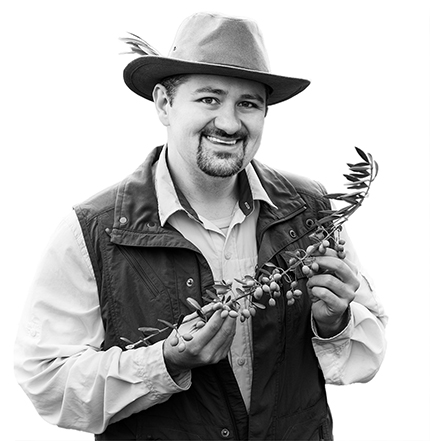
- All are from award-winning producers at the top of Chile’s vibrant olive oil scene.
- All are brimming with bright, enticing flavors, perfect for enhancing summer salads, grilled seafood and meats, even desserts (try some drizzled on vanilla ice cream!).
- All three are packed with healthful polyphenols and are independently lab certified to be 100% extra virgin.
- All three are Club exclusives, available nowhere else in America.
Where in the world is the Olive Oil Hunter? You might just as well ask, “When in the world?” While the US is gearing up for summer, right now I’m enjoying late autumn—olive harvest time—in Chile, my favorite South American destination on my ever-revolving mission to bring you the freshest, finest extra virgin olive oils on earth.
Farmer’s Market to the World
Agriculture is the mainstay of Chile’s economy—the highways in central Chile are lined with produce packing houses. Gorgeous avocados—palta—are always within reach; one of my favorite snacks is smashed avocado on crusty bread, with a drizzle of fresh olive oil and a sprinkle of sea salt. My only regret is that I’m not here at tomato-time, to savor what I think of as “the essence of summer”: thick slices of plump, red, vine-ripe tomatoes, splashed lavishly with just-pressed olive oil. But you, my lucky Club members, are perfectly poised to do so!
I’ll be the first to admit that back in my school days I probably couldn’t find Chile on a map. Now I know it like the back of my hand—if my hand were a narrow, two-thousand-mile stretch along the Pacific—thanks to Chile’s award-winning, groundbreaking, and vibrant olive oil scene.
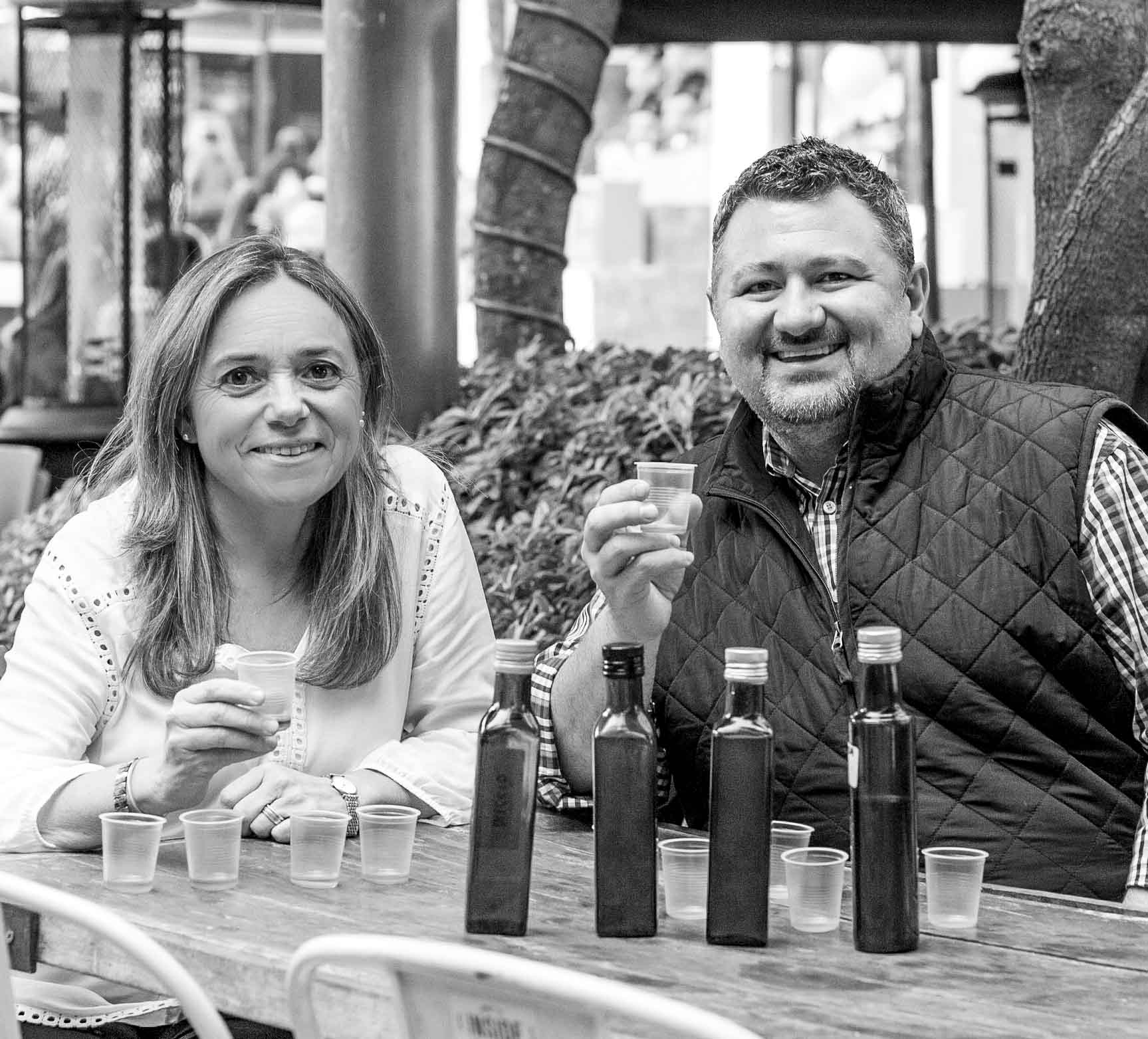
Chile Bursts on the Scene
The first substantial olive groves were planted in Chile only as of the year 2000. Within just a few years—thanks to a Mediterranean-like climate, devotion to horticulture, an absence of olive pests, and expert technical and creative guidance from master millers—the quality and distinction of Chilean extra virgin olive oils had earned them international acclaim.
Bounded by the Pacific Ocean on the west; the Andes Mountains on the east; the world’s driest desert, the Atacama, to the north; and the taper of Patagonia to the south, Chile is only 110 miles across at its widest point. Chile’s diverse geography provides for many microclimates, which create complexity in the flavors of its freshpressed olive oils.
I first visited Chile and its olive groves in 2005, at which time I met several of the pioneering producers. As soon as the trees bore fruit, I was thrilled to introduce Chilean oils to my Club members, and each year since I have delighted in bringing you exclusive Chilean oils—especially at a time of year when just-pressed olive oils are otherwise unavailable (or very hard to come by) in the Northern Hemisphere.
Dusty Roads to Liquid Gold
When I landed in Santiago, one of the first things I noticed was that the Andes, normally snow-capped, were bare. My scouts on the ground had reported, “No rain, all summer. Not a drop.” For several years running, Chile has been enduring what scientists have dubbed “mega-drought,” or megasequía. Most farms are equipped with irrigation systems that rely on water from wells or lakes. But snow melt from the Andes helps replenish those ground sources, so the visual of bald mountains was uncanny, like a good friend who’s gotten a subtly strange haircut.
Many of the roads to, from, and around olive farms are dirt or gravel, and in Chile they seemed paved with dust, all 1,400 miles of them. While touring the groves of Deleyda (see profile below) with producer Christian Coddou, I was sputtering some numbers in “Spanglish,” trying to estimate the acreage. Finally—in a truly resourceful move—Christian wrote out the specific sum with his index finger in the dust on the dashboard of our rented gray SUV. (The same way we kids used to inscribe “Wash Me!” on a dirty car.)
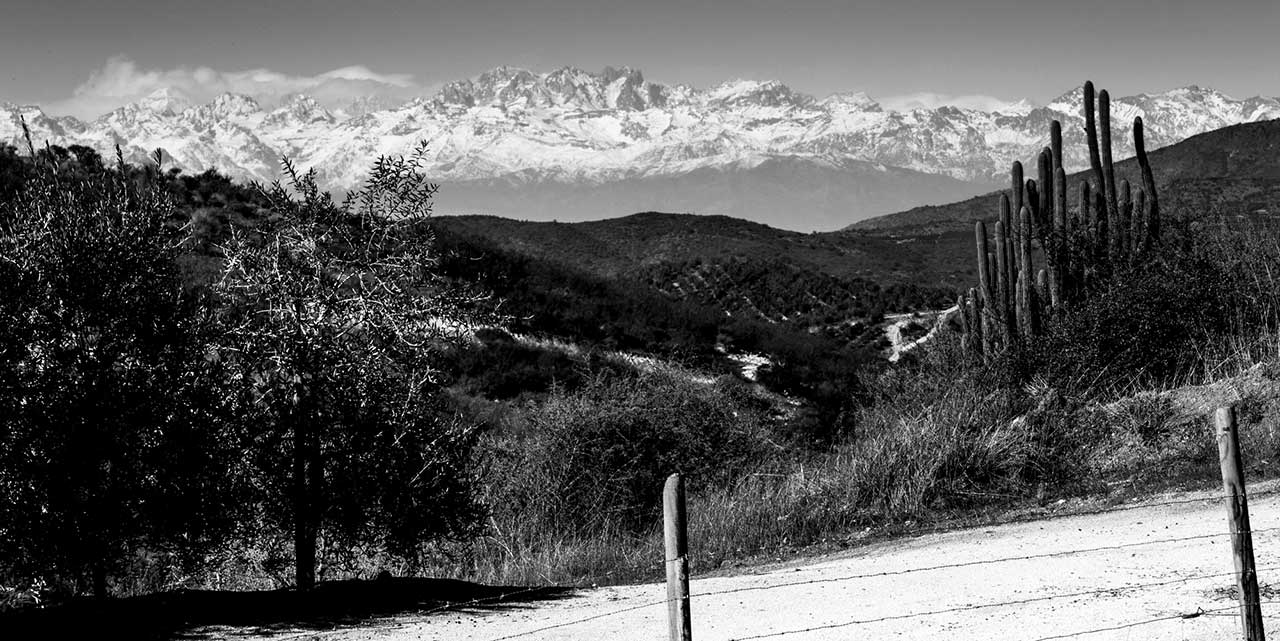
In spite of the drought, my Merry Band of Tasters and I weren’t worried about the olives, as we work with producers who meticulously manage their irrigation resources. Also, a degree of water deprivation has its benefits, as it helps concentrate the perfumes and flavors in the resulting olive oil.
Several farms anticipated excellent harvests. I was particularly eager to taste the Frantoio at the Deleyda groves; I was also intrigued by advance word that, on more than one farm, Koroneiki olives—a Greek variety—promised to be outstanding. The threat in Chile, where the seasons can shift in a blink, would be frost. We had to ensure the olives were picked and pressed before the temperature dropped. That was fine by me, as I prefer that the fruit be pressed green, for greater flavor and higher polyphenol content.
The Beauty of the Blend
Chilean groves tend to focus on a handful of olive varieties (in contrast to the more than 500 found in Italy): Arbequina, Coratina, Koroneiki, Arbosana, Frantoio, Picual. This minimalist approach presents a wonderful opportunity for artful, finely calibrated blending, and it gave me and my colleagues—including Italian master miller Duccio Morozzo della Rocca—the chance to create three exquisite blends that are truly greater than the sum of their parts.
Before embarking on the 5,000-mile flight home, I was delighted to spend an afternoon with Maria Luz Hurtado (see photo, opposite page), director of the olive oil diploma program at the University of Santiago. An ambassador for Chilean olive oils, Maria was the teacher of two producers I worked with this quarter (Deleyda and Alonso), as well as dozens of other influential people in Chile’s olive oil scene.
Maria was thrilled to learn about my Club and the level of olive oil appreciation demonstrated by its members. She is so proud that these beauties will be representing Chile on your summer tables. I can’t wait for you to taste them with just about everything—splash them generously on salads, grilled meats, vegetables, and seafood, and drizzle them over tender sweet corn. Mmmmmm… A mi gusta!
Happy drizzling!

T. J. Robinson
The Olive Oil Hunter®
This Quarter’s First Selection

If you’ve been a Club member for a while, you’ve savored the artistry of my dear friend and devoted champion of the Fresh-Pressed Olive Oil Club, Duccio Morozzo della Rocca. An internationally celebrated olive oil judge, taster, and master miller, Duccio, like myself, works and travels almost year-round, as the global olive harvests trace the earth’s trip around the sun. He sent word that he’d also be in Chile during the time of my quest, advising and overseeing the harvest at the Swett family farm in the Colchagua Valley, about 100 miles south of Santiago.
I love driving through central Chile at this time of year. The endless vineyards, olive groves, and other plantings blanket both sides of the road like an autumnal patchwork quilt, rippling out in squares of burgundy, gold, dark purple, and silver-green.
Duccio was as excited as I was to collaborate on an exclusive blend for my Club, showcasing this season’s beautiful fruit in what he has dubbed “the perfect example of Chilean agriculture.” The extensive groves of the Swett family farm inhabit a complex landscape, with many different microclimates and sharp shifts in geography. Thus the same variety of olive—yet grown, for instance, on both sides of a hill—can yield very different aromas and flavors, depending on the sun exposure and altitude.
On the ground in advance, Duccio observed this season’s crop coming to fruition, and pronounced it outstanding. He gave a special nod to the Koroneiki olives, a Greek variety, and the Arbequina, a Spanish variety that is ubiquitous in Chile, but, as Duccio observes, diplomatically, “Not everybody does it well.” Duccio prefers to sample the olives right from the tree, tasting for potential, finding the spots with just the right amount of sun to build aromas in the fruit, imagining how he’ll orchestrate the flavors together. (See us inspecting the rows of olive trees in the photo at left.)
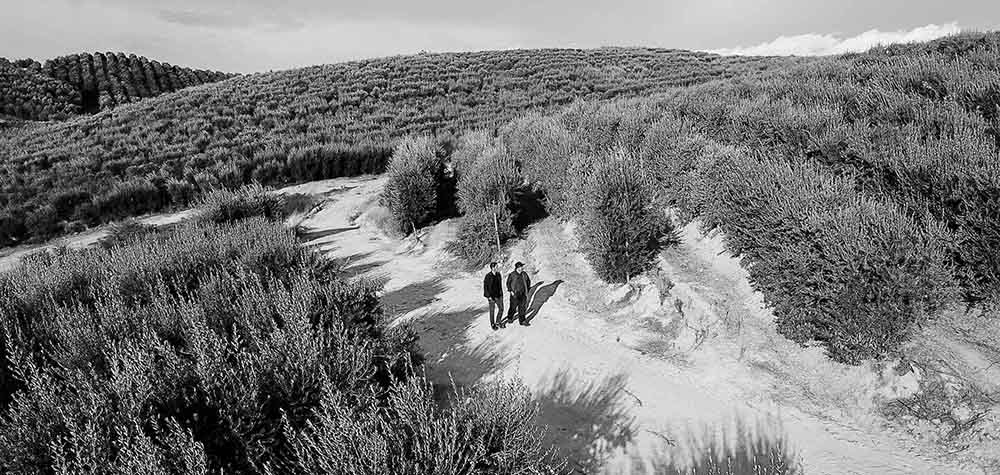
For a few days we were given reign over the field for a special harvest, exclusive to my Club, in order to procure the perfect ingredients for what we had in mind: a complex, intense, pleasing, extraordinary oil.
Providing the base of the blend, Arbequina brings green and sweet aromas; Duccio describes its sensory impression as “the fresh soul of the olives.” We harvested two different batches of Arbequina, from separate locations, and pressed them separately as well. One batch was pressed using a traditional hammer crusher, whereas the other was milled using a super state-of-the-art knife crusher. Both methods produce desired but different results, enabling us to glean more complexity and nuance from the Arbequina: variations on a theme. The Koroneiki, in a smaller amount, adds dimension to the blend, giving it pungency, a lively bitterness, and a bit of a kick.
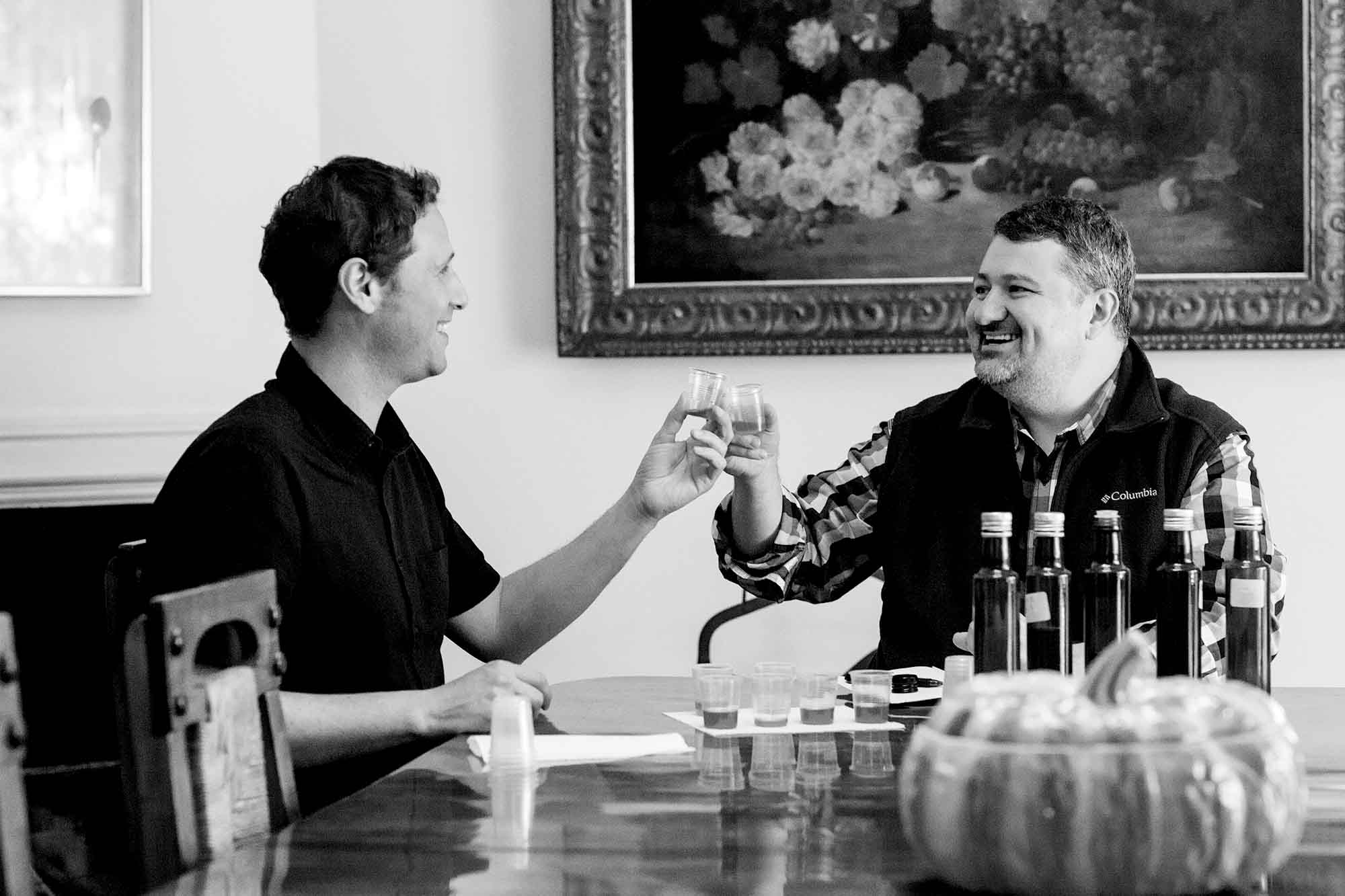
Trained as a composer, Duccio brings a musician’s appreciation of harmony, interplay, and resonance to the creation of an optimal blend. He also brings his irrepressible personality and love of life into the process, beginning our blending session by announcing, “Let’s have some fun!” Believe me, we did! (See photo at right.) The brilliant blend we created is bursting with personality. It’s a celebration of Chilean agriculture; an expression of gratitude for you, my wonderful Club members; and an almost magical levitation of the sensory elements that construct an optimal olive oil: greenness, sweetness, bitterness, and spice.
We were so delighted with the result that Duccio bottled extra to give to the grove workers, so they can enjoy the fruits of their labors. All of us are so very proud to share it with you!
Impressions and Recommended Food Pairings:
Grassiness is forward on the nose, as are the fruity notes of green banana and apple. Minty and fresh, with hints of Belgian endive, fennel, and lime zest, with a fillip of green peppercorns. In the mouth, expect a crescendo of rich, round food associations—from sweet (bananas, lemon meringue pie, white chocolate, cocoa butter) to savory (celery leaves, chicory, ginger), with the subtle nuttiness of almonds. Clean, bright mouthfeel (again, minty) with a long, warm Szechuan peppercorn-like finish.
My tasters and I noted this beautifully balanced, somewhat sweet olive oil would be great for baking. (It would shine in quick breads, pastries, or the Lemon Blueberry Zucchini Cake shown below.) It would also be perfect for drizzling over summer salads, especially those featuring fruit; mild fish and shellfish; poultry; fresh or non-aged cheeses; grilled vegetables; sweet potatoes; lentils; rice; eggs; and as always, warm crusty bread.
This Quarter’s Second Selection
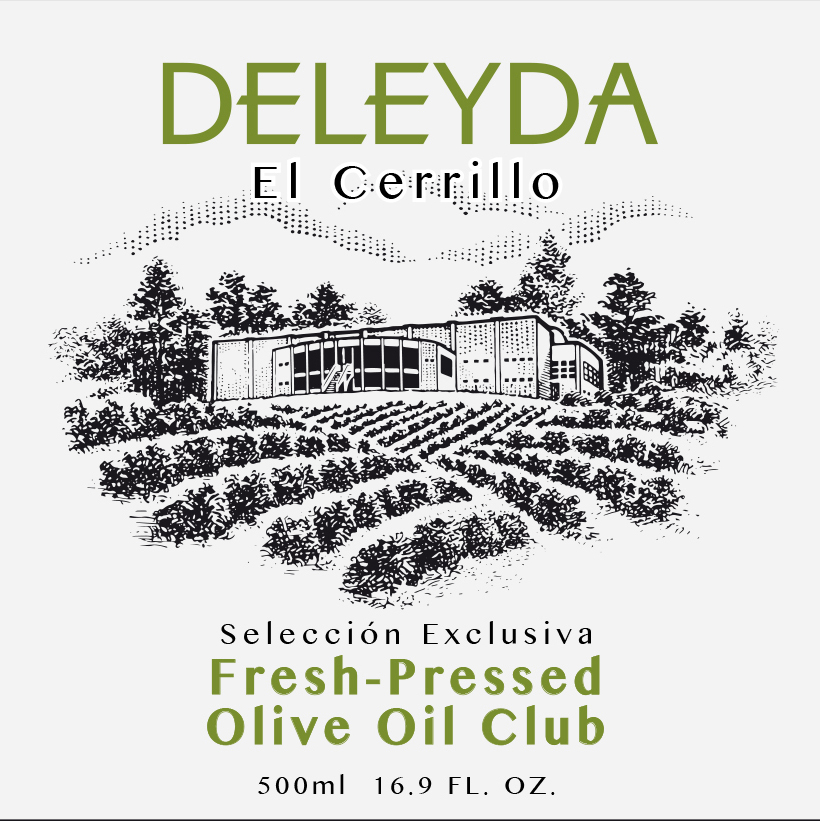
Make the trek up the pyramid-like hill in the center of Deleyda’s El Cerrillo olive groves, and you’ll be rewarded with breathtaking views of the property and the mountain-rimmed Colchagua Valley that cradles it. (El Cerrillo means “the hill.”) Bring food, too, because the wooden pavilion at the hill’s quartz-strewn summit is a perfect place for a fall picnic. On this unseasonably warm day, I’ve brought a colorful quinoa salad with lemon wedges and heavenly just-pressed extra virgin olive oil.
From my high vantage point, I contemplate the circumstances that brought me to this special place. I don’t recall how I first came to know of Deleyda, but during the past 13 years, I have cultivated a strong network of friends and contacts in Chile. Any one of them could have alerted me to this quality-obsessed producer. (Deleyda’s oils have been featured in Flos Olei, a prestigious guide to the world’s best olive oils, since 2009—quite an accomplishment).
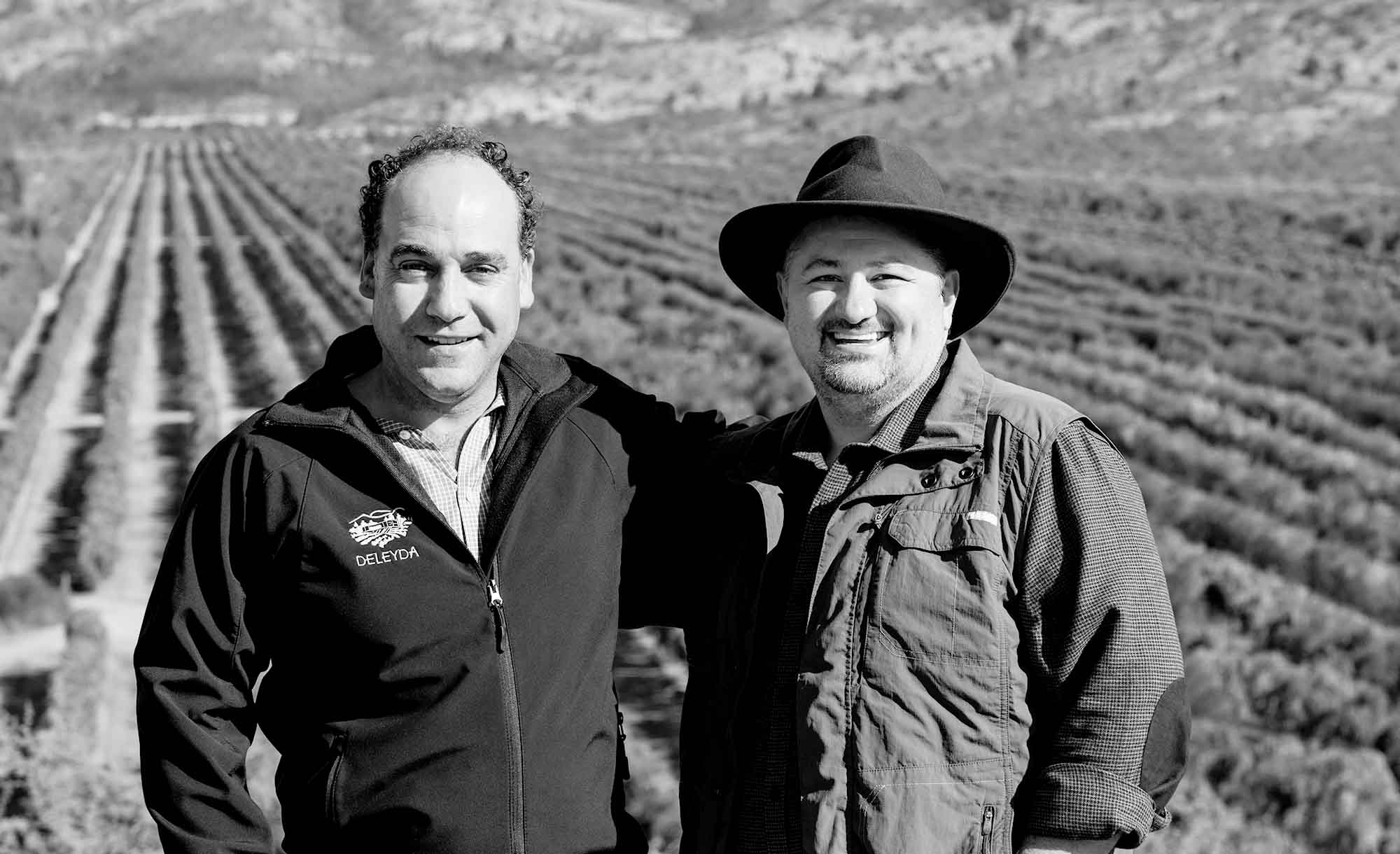
For several years, I auditioned Deleyda’s extra virgin olive oils, hoping one day to include them in my Chilean lineup. The oils showed much promise, which is why I persisted in tasting them. But they weren’t exactly what I was looking for. Until now.
Deleyda was founded in 2006 by five partners committed to producing super highquality Chilean olive oil. They evaluated more than 20 properties before purchasing the El Cerrillo land in the O’Higgins Region. Access to water was a must, of course.
The O’Higgins Region, a bit smaller than the state of Massachusetts, is agriculturally blessed with a climate similar to that of the Mediterranean. Like Russia’s famous nested dolls, it harbors contoured valleys within valleys. Tree fruit and olives are among the products it trucks over the ribbon-like Ruta Cinco to Santiago and the world beyond.
Planted in 2008, the 400-acre farm is itself a valley. It hosts a number of microclimates that give complexity to the olives. My scouts on the ground predicted 2018 could be an exceptional year as long as Mother Nature cooperated. And she did! Shortly before my visit, El Cerrillo hosted world-renowned olive oil expert and master miller Dr. Mario Beltrami. Dr. Beltrami, an agronomist from Tuscany, has been a consultant to Deleyda for several years, deftly maximizing its oils’ potential.
Happily, the just-pressed Frantoio, Arbequina, and Arbosana oils I tasted at the on-site high-tech mill with El Cerrillo’s general manager, Christian Coddou, were very impressive. Together we created a beautiful and exclusive blend for my Club members.
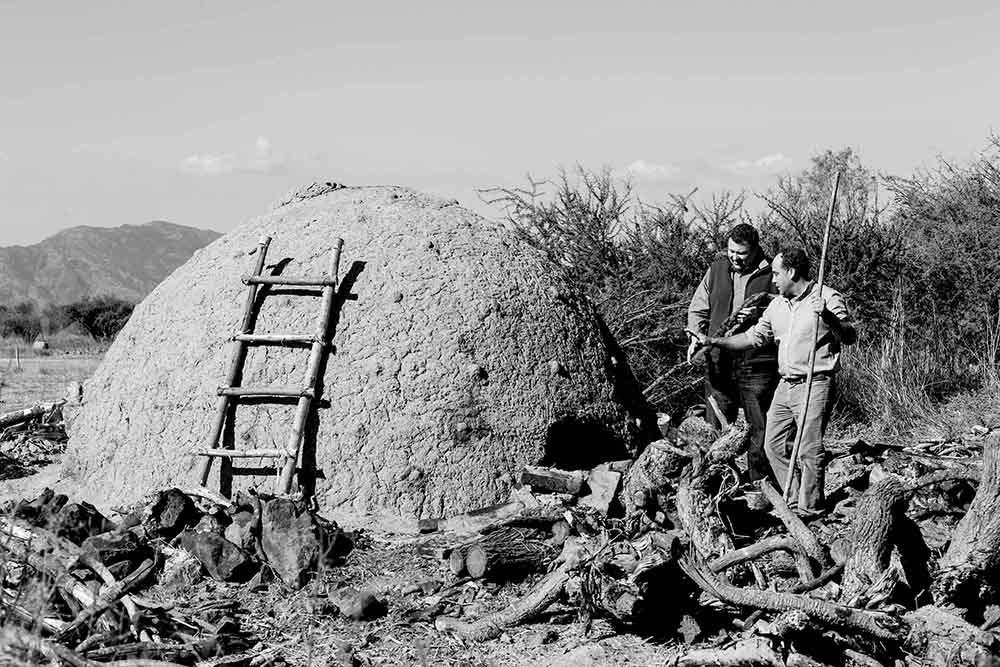
Over a lunch at a local restaurant appropriately named Mestizo (“mixed”), Christian was eager to talk about why this year’s early-harvest oils were so good. The weather was very accommodating, he said, with warm days and cool nights. Luckily, frost did not affect the budding trees in the spring or the harvest-ready fruit in the fall.
The farm actually has a clever defense against frost. Christian explained that solar-powered thermometers positioned throughout the groves send alerts via Wi-Fi if temperatures drop below a preset threshold. A tractor equipped with a blower rushes to the trees and warms the air. I have not seen this technique in play before—more evidence of New World ingenuity.
The continuation of Chile’s drought has reduced water levels in the fruit and concentrated its amazing flavors. With a background in irrigation, Christian gives the trees just enough water to sustain them without diluting the olives’ perfume and essence. Six wells on the property supply the irrigation system. Christian stops watering the trees about a week before harvest.
I am very eager for you to taste the olive oil from this world-class producer. Deleyda is thrilled to share its just-pressed extra virgin olive oil with my Club members, people who will appreciate its outstanding quality and affinity for the foods of summer.
Impressions and Recommended Food Pairings:
On the nose, this medium-intensity olive oil releases the heady scents of almonds, vanilla, banana skin, honeycomb, celery, baby spinach, fennel, and fresh-cut grass. It gives the impression of being both sweet and green, which is confirmed on the palate. Again, we invoked almonds, vanilla, and honey, cut through with the vivifying astringency of lime and the darkly vegetal bitterness of Swiss chard and parsley stems. The spiciness of black peppercorns lingers in the throat, a reminder of this oil’s precious payload of polyphenols.
We recommend pairing this multi-faceted oil with white beans; game meats; lamb shoulder, breast, or shanks; lobster or prawns; duck; beef; salmon; herb-inflected egg dishes, such as frittatas or quiches; oil-rich fish such as salmon, mackerel, tuna, or bluefish; and simple pasta dishes, such as aglio e olio. Perfect, also, for chocolate- or almond-based desserts.
This Quarter’s Third Selection
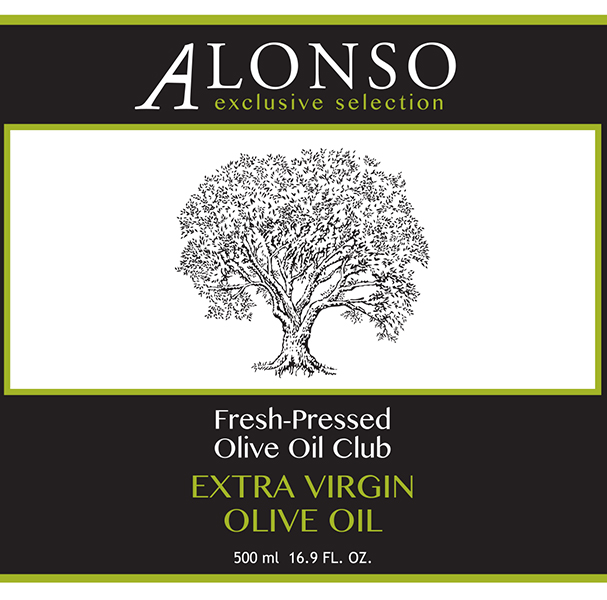
Not even in Corleone, Sicily, had the Olive Oil Hunter been threatened before. I certainly didn’t expect it in friendly Chile. But several people heard Juan Jose Alonso jokingly deliver an ultimatum: “T. J., if you don’t come to my beach house this year for a barbecue, I will not sell you any olive oil.”
So I did the only thing I could do—I buckled—and promised Juan Jose (shortened by friends and family to “Juanjo”) my Merry Band of Tasters and I would happily accept his invitation.
That is how we found ourselves navigating our rented SUV to a house party on a twisty, unpaved version of the Pacific Coast Highway. Our destination was Puertecillo, a tiny seaside town (population: less than 100) mostly known only to hardcore surfers. I imagine this is what Malibu must have looked like back in the day. Juan Jose and his young family live there.
Life, however, hasn’t always been a party for the Alonso family.
Its patriarch, Abel Alonso, was a Basque refugee from Spain’s civil war in the 1930s.
Abel’s father had been imprisoned by the despotic military dictator Francisco Franco, who ruled the country for decades. As a teenager, Abel and his parents fled to Chile. Though he had little education, young Abel found work in a shoe factory. He eventually built one of the largest and most successful shoe companies in the country.
But annual visits to his homeland after Franco’s death in 1975 made Abel long to establish an olive farm in Chile—a living legacy for his five sons and their families. He entrusted Juan Jose with the responsibility of finding a plot of land to make the dream come true.

Even though Juan Jose had his own dream—he had just returned from California with a newly minted master’s degree in Fine Arts and a keen interest in surfing—he didn’t want to disappoint his father or siblings. Eventually, he located a property in the O’Higgins Region of Central Chile that hosted Mediterranean-like conditions, had water reserves (extremely important), and not incidentally, was only 30 minutes from one of Chile’s finest surfing destinations. (The family still teases Juan Jose about this, though he insists self-interest had nothing to do with the decision.)
Today, the farm is a model for New World olive producers and a source of pride for Abel, who now spends much of his time in his beloved Basque country. A 55-acre lake and a series of wells supply the water for a sophisticated irrigation system. A large state-ofthe- art mill ensures olives are pressed within 90 minutes of being harvested—an amazing turnaround time that preserves freshness and protects precious polyphenols. Day-to-day operations are managed by another son, Ignacio Alonso, giving Juan Jose the freedom to pursue art and epic waves. Ignacio is ably assisted by master miller Miguel Molina, who has helped the farm win many olive oil awards.
The 2018 harvest has gone very well so far for the Alonsos. Last year, as you may recall, devastating wildfires licked the edges of the property but were held back by a Herculean effort on the part of the entire team. The drought continues, unfortunately. The lake is the lowest I have ever seen it. Yet, the oils continue to thrill. I am particularly proud of this year’s blend, which showcases Alonso’s lovely Picual, Koroneiki, and Coratina varietals. (See my tasting notes below.)
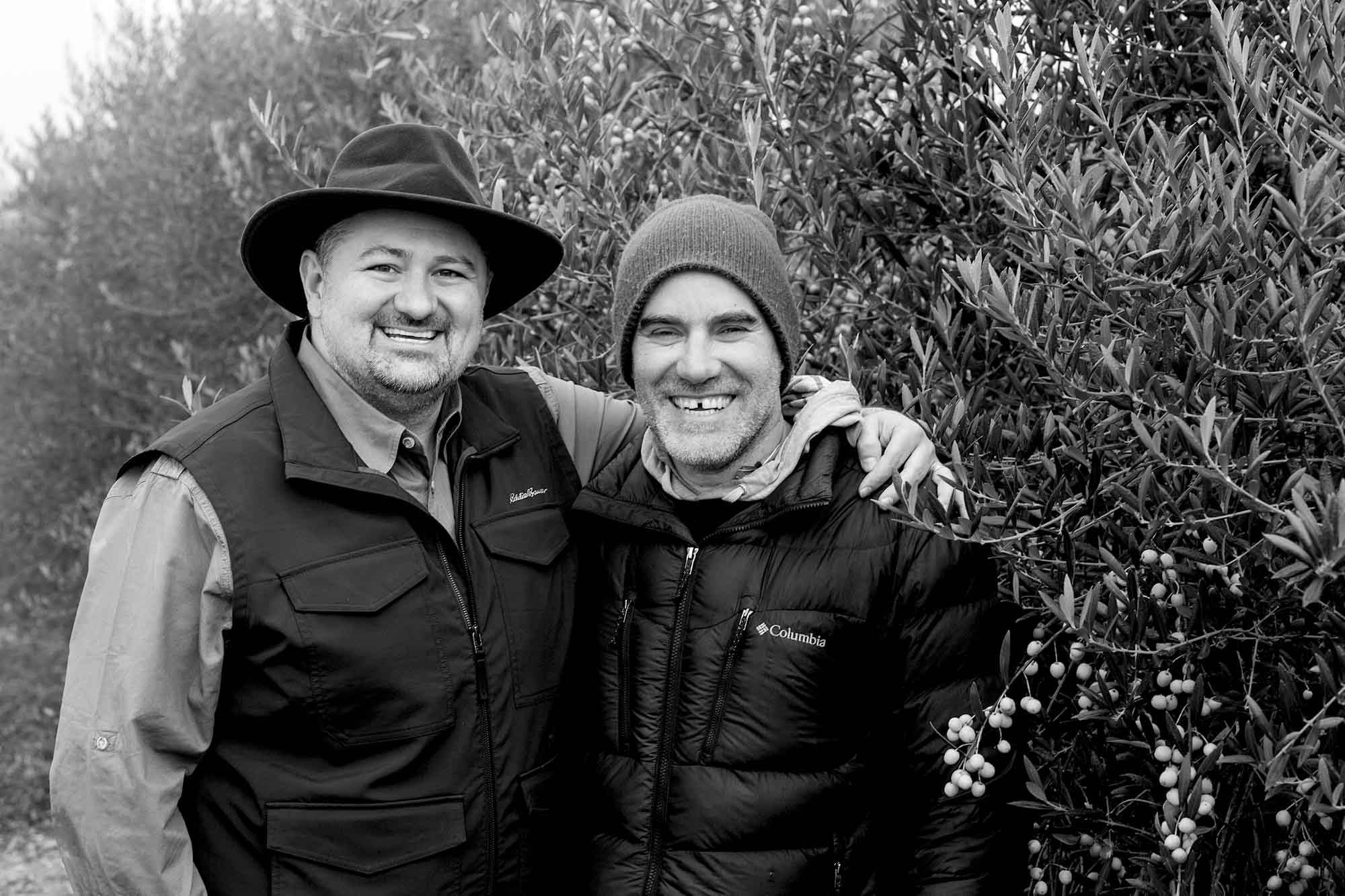
Meanwhile, I got the blue-ribbon tour of Juan Jose’s charming beach house and its bohemian-inspired décor. (My visit coincided with his son’s fourth birthday party.) There’s something to see on every surface. Even the commode in the bathroom is gaily painted. Only the homemade chicken empanadas, olive oil-honeycoconut macaroons, and a cold Escudo beer distracted me from the riot of color. It was a joyous celebration. I hope you experience some of that joy when you open the bottle. Impressions and
Recommended Food Pairings:
Boldly, deeply green on the nose, leading with fresh culinary herbs like thyme, rosemary, and tarragon. The green theme continues with tomato leaf, green tea, kiwi, kale, and peppery arugula or nasturtium leaves. It was described as “chewy,” with just a touch of sweetness reminiscent of blackberries. Very intriguing on the palate, exhibiting the bitterness of radicchio and the spiciness of arugula. Our taste buds were met with oncoming waves of tomato leaf, celery, bitter chocolate (think cocoa nibs), as well as mint, rosemary, and thyme. Not unexpectedly, we experienced a long, peppery finish. Our tasting affirmed our decision to position this oil as our boldest in the lineup.
Of course, this muscular oil should be paired with assertively flavored foods. Bistecca Fiorentina (wood-grilled beef porterhouse) comes to mind (see our recipe for Flank Steak with Salsa Verde on page 17), along with bruschetta; swordfish, sardines, and tuna; sliced tomatoes; tomato soup or sauce; gazpacho; and gremolata; even chocolate ice cream. One taster dubbed this oil “pesto in a bottle.” It will be a stalwart in your summer kitchen and, in
Olive Oil and Health
Reprinted from an article by the Endocrine Society, March 20, 2018.
The heart-healthy Mediterranean diet also appears to be good for an older woman’s bones and muscles, a new study of postmenopausal women in Brazil finds. The study results were presented Monday, March 26, at ENDO 2018, the Endocrine Society’s 100th annual meeting in Chicago.
The researchers reported finding higher bone mass and muscle mass in postmenopausal women who adhered to a Mediterranean diet than in those who did not. This way of eating involves a high intake of fruits and vegetables, grains, potatoes, olive oil and seeds; moderately high fish intake; low saturated fat, dairy, and red meat consumption; and regular but moderate drinking of red wine. The Mediterranean diet has been linked to a lower risk of heart disease, diabetes, cancer, and certain other chronic diseases.
Few studies, however, are available about the Mediterranean diet and its effects on body composition after menopause, said the study’s lead investigator, Thais Rasia Silva, Ph.D., a postdoctoral student at Universidade Federal do Rio Grande do Sul in Brazil. This information is important, she said, because menopause, with its decline in estrogen, speeds a woman’s loss of bone mass, increasing her risk of the bone-thinning disease osteoporosis and broken bones. In addition, menopause and aging reduce muscle mass. Silva said declines in skeletal muscle mass and strength in older people are major contributors to increased illness, reduced quality of life and higher death rates.
Silva and her co-workers conducted their study in 103 healthy women from southern Brazil, who had an average age of 55 and who had gone through menopause 5.5 years earlier, on average. All women underwent bone scans to measure their bone mineral density, total body fat, and appendicular lean mass, which was used to estimate skeletal muscle mass. The subjects also completed a food questionnaire about what they ate in the past month.
A higher Mediterranean diet score (MDS), meaning better adherence to the Mediterranean diet, was significantly associated with higher bone mineral density measured at the lumbar spine and with greater muscle mass, Silva reported. This association, she said, was independent of whether the women used hormone therapy previously, their prior smoking behavior, or their current level of physical activity, as measured by wearing a pedometer for six days.
“We found that the Mediterranean diet could be a useful nonmedical strategy for the prevention of osteoporosis and fractures in postmenopausal women,” Silva said. Given the many health benefits of the Mediterranean diet, Silva added, “Postmenopausal women, especially those with low bone mass, should ask their doctor whether they might benefit from consuming this dietary pattern.”
Kudos from Club Members
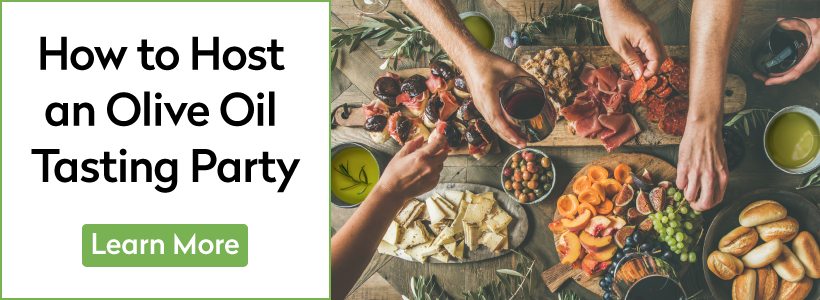
Recipes
 Roasted Peppers with Parmesan Breadcrumbs This simple but jewel-like appetizer or side dish can be served hot or at room temperature. Don’t forget the last drizzle of olive oil for a spectacular presentation! view recipe
Roasted Peppers with Parmesan Breadcrumbs This simple but jewel-like appetizer or side dish can be served hot or at room temperature. Don’t forget the last drizzle of olive oil for a spectacular presentation! view recipe Portobello Mushrooms with Chipotle Guacamole The mushrooms can be grilled up to a day ahead, but make the guacamole an hour or two before serving. Cover tightly with plastic wrap (make sure the wrap makes contact with the guacamole) and refrigerate. view recipe
Portobello Mushrooms with Chipotle Guacamole The mushrooms can be grilled up to a day ahead, but make the guacamole an hour or two before serving. Cover tightly with plastic wrap (make sure the wrap makes contact with the guacamole) and refrigerate. view recipe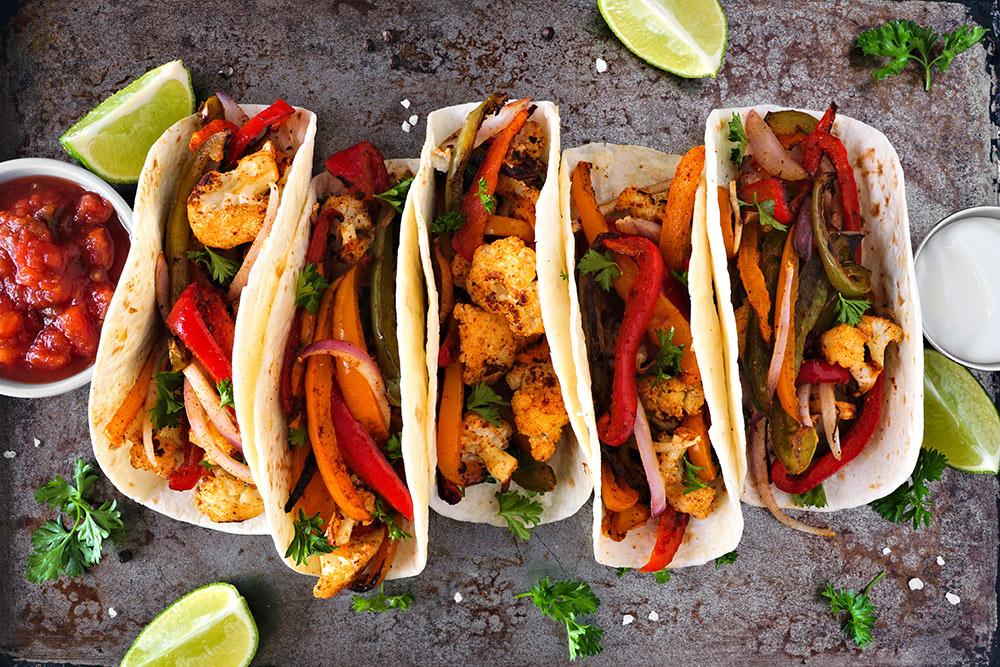 Grilled Cauliflower Fajitas With over 6 percent of Americans identifying as vegan and millions more describing themselves as “vegetarianinclined,” a meatless main course option belongs in your recipe repertoire. view recipe
Grilled Cauliflower Fajitas With over 6 percent of Americans identifying as vegan and millions more describing themselves as “vegetarianinclined,” a meatless main course option belongs in your recipe repertoire. view recipe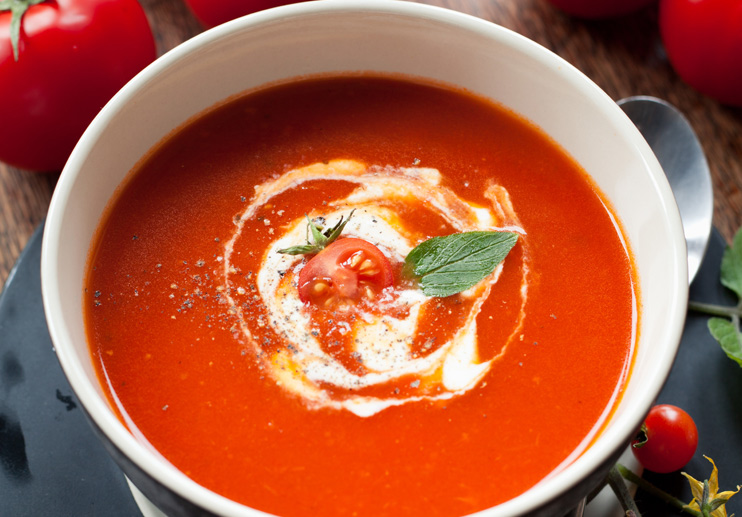 Fresh Tomato Soup Make this simple soup when sun-ripened tomatoes come into the market. If you’re unfamiliar with it, burrata is a water-packed, milky mozzarella-like cheese filled with cream. Substitute a spoonful of fresh ricotta if burrata is unavailable. view recipe
Fresh Tomato Soup Make this simple soup when sun-ripened tomatoes come into the market. If you’re unfamiliar with it, burrata is a water-packed, milky mozzarella-like cheese filled with cream. Substitute a spoonful of fresh ricotta if burrata is unavailable. view recipe Lemon Blueberry Zucchini Cake This beautiful cake is dense, as it was originally adapted from a quick-bread recipe. Before juicing the lemon, remove the zest in long thin strips and reserve for a garnish. view recipe
Lemon Blueberry Zucchini Cake This beautiful cake is dense, as it was originally adapted from a quick-bread recipe. Before juicing the lemon, remove the zest in long thin strips and reserve for a garnish. view recipe Oatmeal With Olive Oil And Berries Fruit-topped oatmeal drizzled with extra virgin olive oil is a lovely way to greet the morning, hitting just the right savory and sweet notes. Use whatever fruit you have on hand—sliced bananas, diced fresh peaches, strawberries, etc. view recipe
Oatmeal With Olive Oil And Berries Fruit-topped oatmeal drizzled with extra virgin olive oil is a lovely way to greet the morning, hitting just the right savory and sweet notes. Use whatever fruit you have on hand—sliced bananas, diced fresh peaches, strawberries, etc. view recipe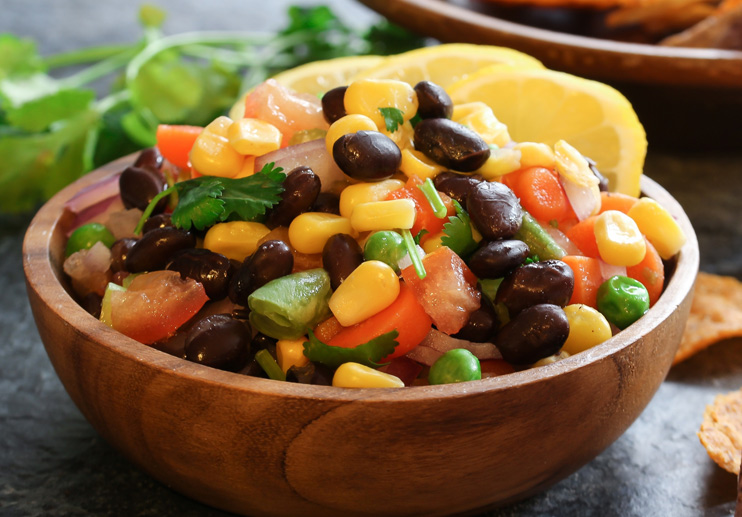 Black Bean and Corn Salad This colorful side dish is potluck-worthy, and with the addition of sliced grilled chicken, pork, or steak, is substantial enough to serve as a main course. Diced avocado is an optional ingredient. If you’re short on time, substitute canned black beans (drained, thoroughly rinsed, and drained again) for the dried. view recipe
Black Bean and Corn Salad This colorful side dish is potluck-worthy, and with the addition of sliced grilled chicken, pork, or steak, is substantial enough to serve as a main course. Diced avocado is an optional ingredient. If you’re short on time, substitute canned black beans (drained, thoroughly rinsed, and drained again) for the dried. view recipe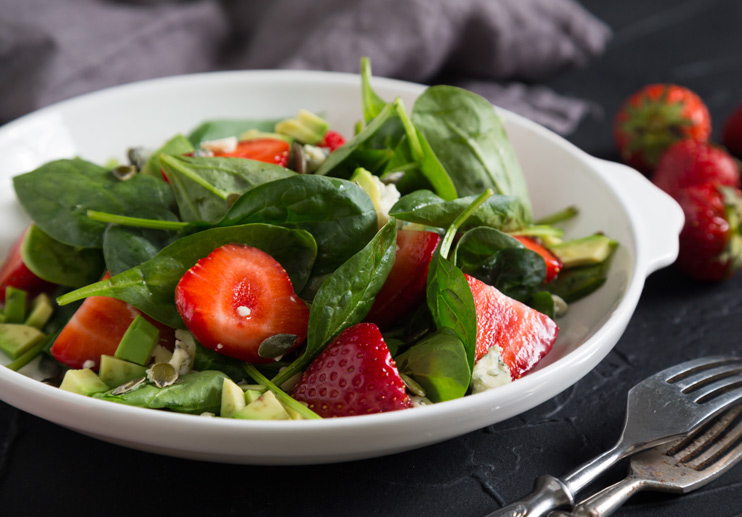 Spinach and Strawberry Salad with Bacon My wife, Meghan, and I enjoyed this simple salad on the first day of our Chilean olive oil expedition, and we recreated it as soon as we returned to Asheville. view recipe
Spinach and Strawberry Salad with Bacon My wife, Meghan, and I enjoyed this simple salad on the first day of our Chilean olive oil expedition, and we recreated it as soon as we returned to Asheville. view recipe Garlicky Herbed Chicken Halving or spatchcocking the chicken enables it to cook faster—a plus on busy weeknights. To spatchcock a bird, place it breast-side down and remove the backbone with kitchen shears or a sharp knife. Flatten with the palm of your hand. view recipe
Garlicky Herbed Chicken Halving or spatchcocking the chicken enables it to cook faster—a plus on busy weeknights. To spatchcock a bird, place it breast-side down and remove the backbone with kitchen shears or a sharp knife. Flatten with the palm of your hand. view recipe Grilled Flank Steak with Salsa Verde Maintain a cool kitchen by taking the party outside. The key to tender flank steak is to cook it to medium-rare, then slice thinly on a sharp diagonal. view recipe
Grilled Flank Steak with Salsa Verde Maintain a cool kitchen by taking the party outside. The key to tender flank steak is to cook it to medium-rare, then slice thinly on a sharp diagonal. view recipe
